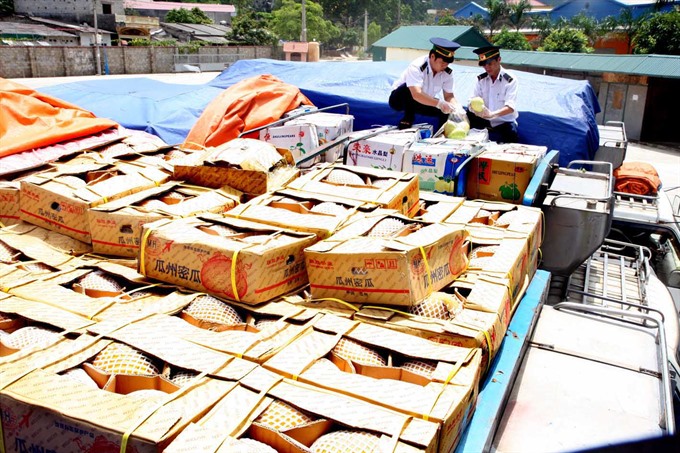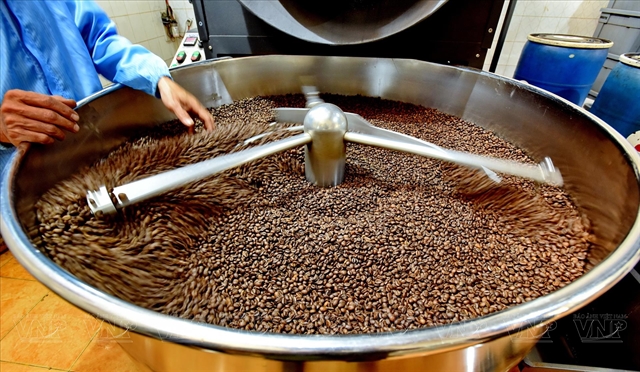 Economy
Economy

The zero per cent tariff under the ASEAN-China Free Trade Agreement (ACFTA) will bring more goods from ASEAN and China to Việt Nam, especially Chinese fruits.
 |
Officials check fruit imported from China at the Tân Thanh border gate in northern Lạng Sơn Province. — VNA/VNS Photo Đình Huệ |
HÀ NỘI – The zero per cent tariff under the ASEAN-China Free Trade Agreement (ACFTA) will bring more goods from ASEAN and China to Việt Nam, especially Chinese fruits.
This will create more competition for local products, according to experts. The Government has issued a decree on special preferential tariffs for ASEAN and Chinese products for the 2016-18 period according to commitments under the ACFTA. Under the decree, hundreds of goods from ASEAN and China will enjoy zero per cent import tax to Việt Nam. The goods include vegetables, fruits, processed or preserved fish and other kinds of seafood, as well as cacao and cacao products, cereal, flour and meat.
According to the commitments at ACFTA, Việt Nam will abolish tax or reduce it to zero per cent for 90 per cent of existing tariff lines by the end of 2018, while the remaining 10 per cent of tariff lines will see it reduced by 2020. A representative from the Việt Nam Chamber of Commerce and Industry’s WTO Support Centre said the reduction of import tariffs for ASEAN and Chinese goods would create strict competition between ASEAN, Chinese goods and local products.
General Statistics Office (GSO) statistics showed that in the first nine months of this year, Việt Nam had the highest import of goods from China, with total import value at $36 billion. Its trade deficit with China reached $21.3 billion, Người Lao Động newspaper reported. Local enterprises imported from China seafood valued at $45.3 million, vegetables and fruit at $146.9 million, fabrics at $3.93 billion and material for textile, garments, leather and footwear industries at $1.38 billion, as well as computer and electronic products valued at $4.1 billion, machine and equipment at $6.5 billion and steel at $3.2 billion.
Nguyễn Thế Bảo, director of Suối Lớn Agricultural, Service, Trade and Tourism Co-operative in southern Đồng Nai Province, said mango growers studied supply at home and also in neighbouring countries to make plans accordingly on production, trading and competition. Depending on the prevailing situation, Vietnamese mangos were exported to Thailand, Cambodia and vice versa. Meanwhile, after many years of exporting mangos from Việt Nam to China, the neighbouring country had begun exporting its mangos to Việt Nam to compete with local products.
Nguyễn Công Thừa, chairman and general director of Anh Đào Agricultural Service Co-operative in the central highlands Lâm Đồng Province, said demand for fruit in the home market had increased, therefore there were times the market lacked supply of fruits and their import surged. As a result, in the future, local farmers would face strict competition from imported fruit products because of their small and medium production scales with high production cost, while China’s producers had large production scale with lower production cost, he said.
Meanwhile, Việt Nam did not have many technical barriers for imported fruit and lacked close control for quality and food safety, which was disadvantageous for local fruit producers while competing with imported fruits, he said.
Seafood is also expected to face similar competition when the import tax reduces to zero per cent under the ACFTA. According to GSO, in the first nine months, Việt Nam’s total import value was $17.1 billion from ASEAN countries and total export value was $12.5 billion, 9.1 per cent lower than the same period last year. Việt Nam’s trade deficit with the ASEAN region reached $4.6 billion. Goods from the region will have more advantages in entering Việt Nam’s market when the import tax rate is zero per cent.
Meanwhile, the office reported that in the first 10 months of this year, the nation’s export value from vegetable and fruit products reached $2 billion. China was the largest export market for local vegetables and fruit, accounting for 70 per cent of the value. It was followed by South Korea, the United States and Japan. Exporters said Việt Nam’s frozen fruit exports to Europe and North America suddenly increased during the 10 months due to attractive prices and boost in communication for Vietnamese fruits in those markets. — VNS









